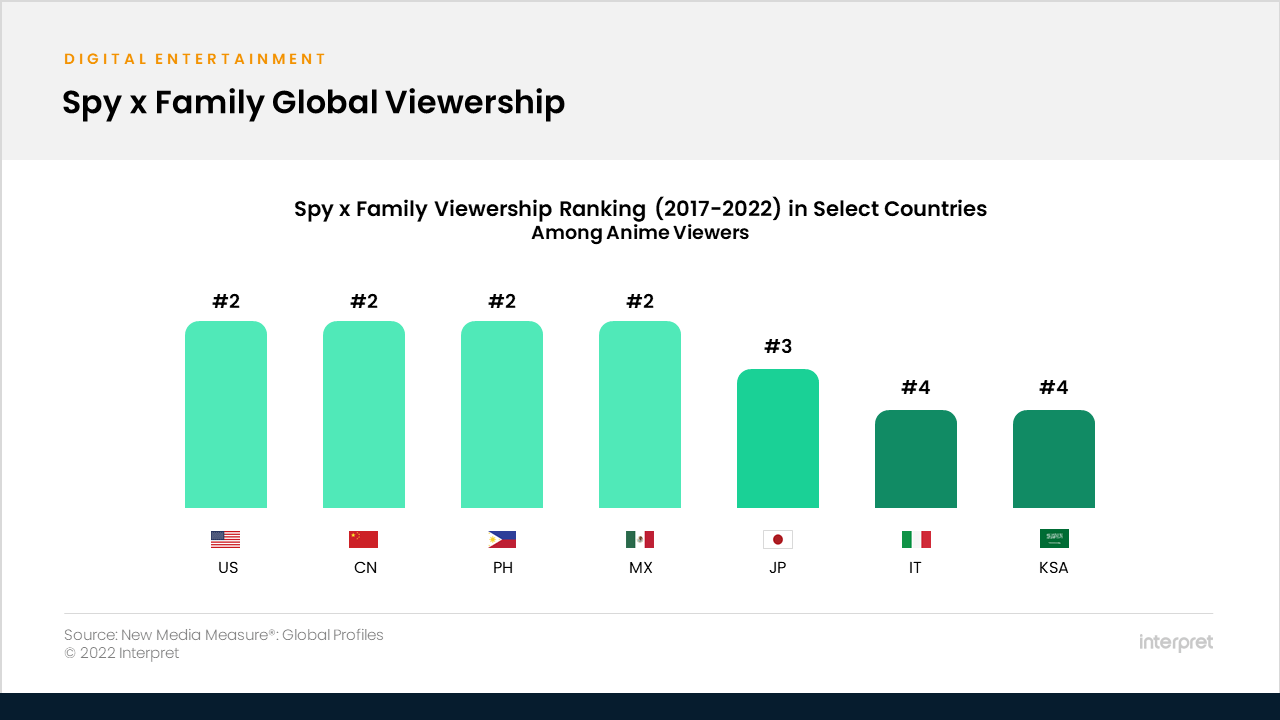Spy x Family is a consistent overperformer across almost all fifteen countries that Interpret surveyed in late 2022 as part of its Animeasure research. In the US, it was the second most-watched anime among series that premiered between 2017-2022 (a fairly distant second to Demon Slayer and just edging out Jujutsu Kaisen). Spy x Family’s global success, which Interpret recently discussed in Roland Kelts’ The Japan Times article, is even more impressive given that the majority of anime viewers haven’t watched any major anime premieres in 2022 (suggesting just how powerful the back catalog for anime is).
It’s difficult not to view Spy x Family’s success through the lens of ongoing global conflicts (particularly Russia’s invasion of Ukraine). The series’ Cold War themes and focus on characters striving to maintain peace and avoid war between the East (“Ostania”) and West (“Westalis”) is timely and grounded relative to other more fantastical shōnen series.
Not only is Spy x Family overperforming across markets, but across audiences. Series such as Attack on Titan or Jujutsu Kaisen are credited for expanding the scope of the anime audience, but they’ve typically done so within a similar demographic to existing anime fans.
Spy x Family appears to be carving out a fresh lane for expansion with anime as family-friendly content—not “family-friendly” in the Disney or even My Neighbor Totoro sense, but more like how a Marvel movie or The Lord of the Rings is PG-13. It has a little edge, but as the editor for the series puts it, “there’s a line where violence is given a pass because it’s for comedy, and [we the creators] are always very conscious of that.”
This broad, family target seems to have been an ambition from early on as the editor is aware that “Spy x Family has a broad readership; both adults and kids alike can read it from their own perspectives.”
The anime approach is typically to focus on niche audiences, differing from the riskier Western entertainment studio approach of trying to appeal to a broad audience. The outcome is a higher number of smaller, but profitable properties.
To set out with the goal of capturing a broader audience from the get-go is the sort of audacious move that can court disappointment (see: Disney’s recent Strange World). It may come as little surprise that this bold play comes from a seasoned 10-year team of a 42-year-old mangaka and his veteran editor.
It’s worth noting that two of the main characters in Spy x Family are full-grown adults with the third character being a small child they care for. These uncommon shōnen protagonists help welcome older newcomers while also allowing anime to “grow up” with longtime fans who are looking to share a favorite pastime with their own families.
To continue growing as it has been, anime will need to do more than make gains among its traditional audiences (e.g., young boys), and Spy x Family offers a globally salient template for a new kind of family animation that doesn’t necessarily need Hollywood budgets.








